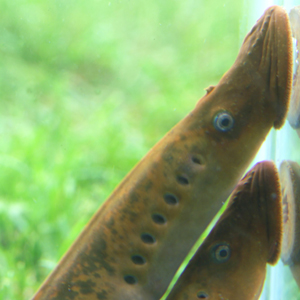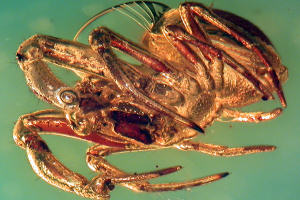It's that time where I feel I have not been educational enough, or haven't written enough, so I force myself to seek out interesting news, usually resulting in me raiding ScienceDaily and giving snippets of insight into what's going on in the science world. This time I have gone a little bit further and have found a wider range of stories, from other sites too. Some are up to date (ish) whereas the odd one might be a few weeks old. Ah well, here goes:
Segmentation Solved?
One of the most important innovations in evolutionary history was the evolution of segmentation, allowing for evolution to become more creative. Many segmented organisms have repeating segments which are identical (think of a centipede or millipede for example) and this allows evolution to co-opt these segments for other purposes, allowing differentiation whilst not disrupting the original function, as one segment continues its job whilst the other alters (this occurs at genetic levels with the duplication of genes and gene complexes too). Increases in differentiation lead to specialisation and the result is often a highly complex structure. Dawkins termed the evolution of segmentation a watershed event in evolution, opening up the door for incredible diversification (see The Ancestor's Tale for details). Organisms such as arthropods and annelid worms are obviously segmented, but so are we and the rest of the chordates. Our segmentation is slightly more obvious when we look at the vertebral column, though keep in mind that segments can fuse and merge together.
A question that has been looming in the minds of scientists is whether or not segmentation evolved once, in a common ancestor of the three aforementioned groups, or whether it is a convergent feature. The three groups are not closely related, so a segmented common ancestor would be back in the Precambrian, around 600 million years ago. If it evolved multiple times, then it may have appeared close to the Cambrian explosion, but then an explanation is needed in order to explain why it evolved in three separate lineages at the same time. A recent study looking at the genes involved in segmentation has found that they are remarkably similar in the separate segmented phyla, suggesting that we all did evolve from a segmented common ancestor and that segmentation evolved only once. See here for more details.
Necks: An Important Evolutionary Innovation
Interestingly the last item of news segues into this one quite nicely. Scientists have found that the evolution of necks, during the transition of our ancestors from sea to land, was a very important step in our evolution. The neurons controlling limbs were moved from the brain into the spinal column (fish still have them in their brains) separating the limbs from the head. This allowed for improved dexterity and coordination in our "fishibian" ancestors which eventually led to diverse limb forms such as those in birds, apes and whales. See here for more.
Stress and Lampreys
The lamprey is a jawless fish which attaches itself to its prey and sucks out their innards, causing havoc in some lakes. Trace our history back, past the fishibian (Tiktaalik roseae) in the last segment but not as far as the common ancestor in the segment before that and you will find that we descend from jawless fish and so share a common ancestor with lampreys. Evolutionary biologists look at relationships like this in order to work out how certain traits evolved as the differences can give great insight, especially when the other organisms have a "primitive" form of the trait being analysed. In this case the system being studied was the endocrine system, especially the production of stress hormones. Humans have more than 30 stress hormones and this study has shown that lampreys appear to have only one, giving insight into how our own, more complex system evolved. See here for more.
Belly Flopping Frogs
This story seems to be on every science site, but it is quite a good one so I thought I would mention it. A study in "primitive" frogs has shown that they evolved the ability to launch themselves through the air before they were able to land properly. The evolution of a proper landing, which came later, made them more efficient and less vulnerable, as anyone who has tried to catch them will know when they continuously hop away. This is a great story which also conjures up amusing images, so read here. It saddens me that frog diversity is really struggling right now, especially in a time when we are discovering some very interesting adaptations among them (who can forget the frog which walks on water; the Pinocchio-nosed frog; the frogs which breathe through their skin; or the elaborate behavioural patterns of some frogs?) who knows what we will never discover?
Sex-y News
A bold new theory for the evolution of sex has been put forwards which looks deep into our prokaryotic past. How meiosis evolved has been baffling scientists for a long time. Meiosis is the process in which the genome is divided and recombined with that of another individual in order to produce offspring. It is generally believed to have evolved from mitosis, the process by which eukaryotes divide; their DNA is divided into two and goes off into two daughter cells. Researchers have now been looking into the reproductive processes in prokaryotes, binary fission and transformation. Binary fission has similarities with mitosis and is where a prokaryote splits its DNA strands to act as templates for two new strands which inhabit the daughter cells. Transformation on the other hand is where bacteria take a segment of DNA and insert it onto the genome of another cell where it recombines. The researchers have suggested that the process of transformation is the precursor to meiosis, not mitosis as most think.
The "basic machinery" for sex appears to have been present in eukaryotes from very early on, whereas the evolution of meiosis from mitosis would suggest a long period where there was no meiosis. The key to the problem appears to be stress; prokaryotes tend to favour transformation in conditions where stress is common and damage to DNA occurs. Similarly, in eukaryotes which reproduce by both mitosis and meiosis, such as yeast, stressful conditions tend to favour meiosis over mitosis. Both transformation and meiosis are utilised during stressful conditions as they combat DNA damage. The researchers have suggested that this gives great insight into how meiosis evolved from transformation. See here for more on this fascinating story.
Red Blood and More Lampreys
Studies have shown that red blood has evolved independently in both jawless fish (lampreys again, for example) and jawed vertebrates. Similar situations, in this case the need to get oxygen around bigger bodies, has resulted in the parallel (or is it convergent?) evolution of haemoglobin in these two lineages. The two groups co-opted completely different proteins for the same role. See here for more.
Smelling Whales
It has long been thought that all cetaceans, the order containing whales and dolphins, were devoid of a sense of smell. After all, toothed whales and dolphins lack many of the necessary features to achieve olfaction (sperm whales, killer whales and dolphins have been studied). The dissection of a bowhead whale brain found that they have enlarged olfactory systems, suggesting that they could possibly smell. Bowhead whales are baleen whales, so they may have kept their sense of smell in order to detect krill, they also have two blowholes, meaning they may have a directional sense of smell. Whale olfaction gives good insight into evolution as toothed whales cannot smell at all, yet descended from mammals which could. A look into their genomes shows that their olfactory receptor genes are there but not able to be used due to mutation. See here for more on the whale olfaction discovery and see here for my own previous discussion of whales and evolution.
Underwater Palaeontology?
Yes it's true, this segment is not going to mention evolution (except in mentioning that I am not mentioning evolution). It also looks at a recent underwater fossil find. Scuba divers searching an underwater cave found the bones of an extinct monkey in the Dominican Republic. The monkey fossil is relatively recent, but comparisons with older fossils is giving insight into, errrm, evolution (oops, sorry). This unusual find may give a lot of information on the divergence of monkeys and apes. See here for more on this story. Although it would likely be very difficult, the idea of underwater palaeontology is quite appealing as we normally look for fossils on land, even though most of the planet is underwater. It is almost as appealing as extra-terrestrial palaeontology, which is the subject of another post maybe...
New Species and Novel Fundraising
David Penney from the University of Manchester has discovered a new species of spider (the world's oldest) and a new species of lacewing encased in amber among others. He is offering people the opportunity to give these species scientific names, at a cost. He is accepting donations of £5,000 or more in order to name the species and raise money to fund his research. It is an excellent idea for fund raising and ordinarily I would hope that the names given would be good ones, but scientists are not always known for giving species insightful names and some get silly or playful (see Richard Fortey's book Dry Storeroom No. 1 for example, or look at the dinosaur Irritator). See here for some beautiful pictures of the fossils and here for the university's public article.
Ducks: More Obsessed With Penis Size Than We Are
Some species of duck compete with penis size in order to win mates. Instead of bulking up like many organisms do, experiments showed the ducks varying their penis size depending on how much competition there was. See here for the article. Also, with the mention of birds, check out this article about sex chromosomes in mammals and birds, it turns out we took opposite paths.
That's all for now, but not quite all I have to talk about. Some of the news I found was worthy of its own post, due later (or tomorrow). That's not to say that these others aren't as interesting, they simply caused less tangents.
Subscribe to:
Post Comments (Atom)











No comments:
Post a Comment